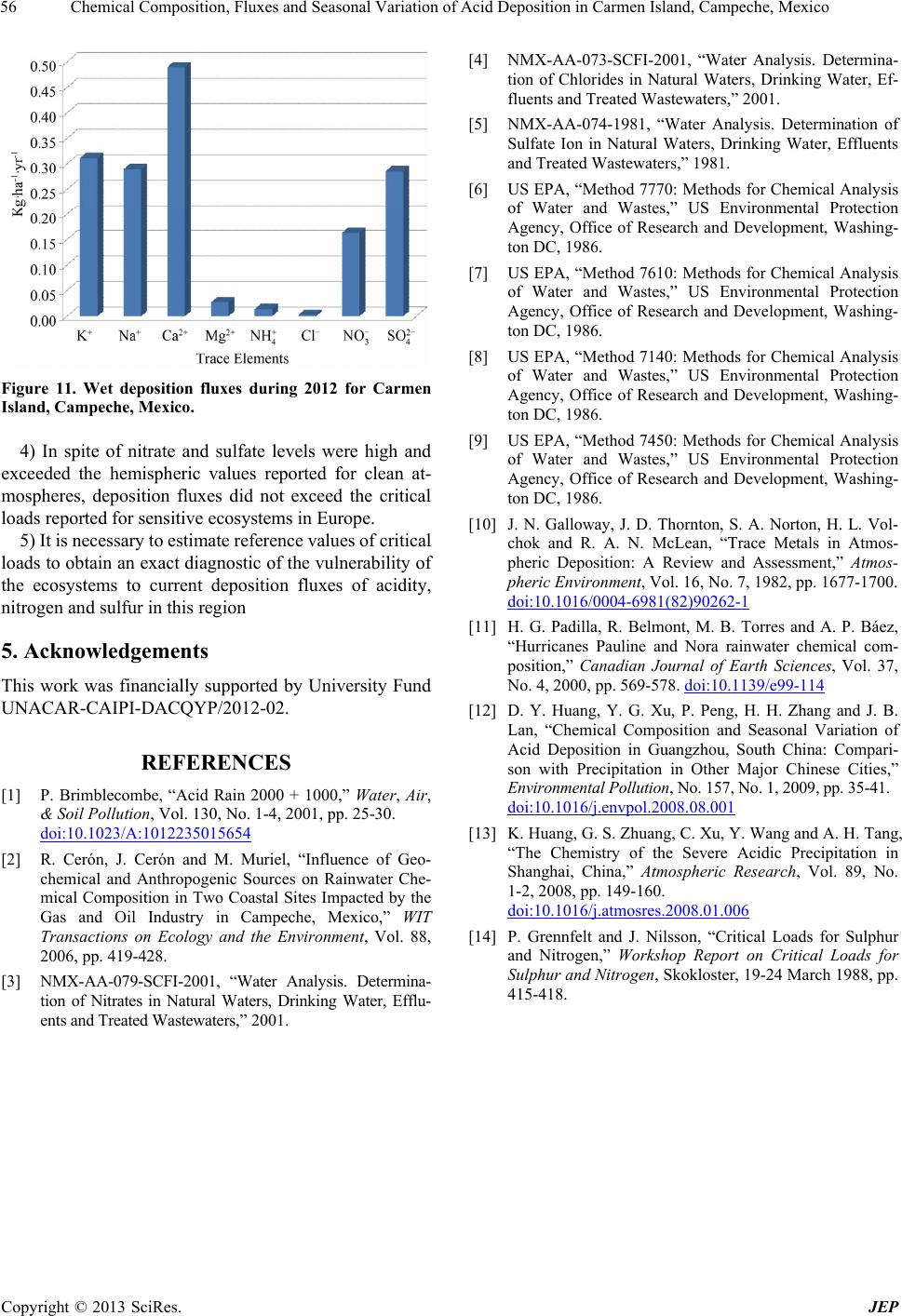
Chemical Composition, Fluxes and Seasonal Variation of Acid Deposition in Carmen Island, Campeche, Mexico
56
Figure 11. Wet deposition fluxes during 2012 for Carmen
Island, Campeche, Mexico.
4) In spite of nitrate and sulfate levels were high and
exceeded the hemispheric values reported for clean at-
mospheres, deposition fluxes did not exceed the critical
loads reported for sensitive ecosystems in Europe.
5) It is necessary to estimate reference values of critical
loads to obtain an exact diagnostic of the vulnerability of
the ecosystems to current deposition fluxes of acidity,
nitrogen and sulfur in this region
5. Acknowledgements
This work was financially supported by University Fund
UNACAR-CAIPI-DACQYP/2012-02.
REFERENCES
[1] P. Brimblecombe, “Acid Rain 2000 + 1000,” Water, Air,
& Soil Pollution, Vol. 130, No. 1-4, 2001, pp. 25-30.
doi:10.1023/A:1012235015654
[2] R. Cerón, J. Cerón and M. Muriel, “Influence of Geo-
chemical and Anthropogenic Sources on Rainwater Che-
mical Composition in Two Coastal Sites Impacted by the
Gas and Oil Industry in Campeche, Mexico,” WIT
Transactions on Ecology and the Environment, Vol. 88,
2006, pp. 419-428.
[3] NMX-AA-079-SCFI-2001, “Water Analysis. Determina-
tion of Nitrates in Natural Waters, Drinking Water, Efflu-
ents and Treated Wastewaters,” 2001.
[4] NMX-AA-073-SCFI-2001, “Water Analysis. Determina-
tion of Chlorides in Natural Waters, Drinking Water, Ef-
fluents and Treated Wastewaters,” 2001.
[5] NMX-AA-074-1981, “Water Analysis. Determination of
Sulfate Ion in Natural Waters, Drinking Water, Effluents
and Treated Wastewaters,” 1981.
[6] US EPA, “Method 7770: Methods for Chemical Analysis
of Water and Wastes,” US Environmental Protection
Agency, Office of Research and Development, Washing-
ton DC, 1986.
[7] US EPA, “Method 7610: Methods for Chemical Analysis
of Water and Wastes,” US Environmental Protection
Agency, Office of Research and Development, Washing-
ton DC, 1986.
[8] US EPA, “Method 7140: Methods for Chemical Analysis
of Water and Wastes,” US Environmental Protection
Agency, Office of Research and Development, Washing-
ton DC, 1986.
[9] US EPA, “Method 7450: Methods for Chemical Analysis
of Water and Wastes,” US Environmental Protection
Agency, Office of Research and Development, Washing-
ton DC, 1986.
[10] J. N. Galloway, J. D. Thornton, S. A. Norton, H. L. Vol-
chok and R. A. N. McLean, “Trace Metals in Atmos-
pheric Deposition: A Review and Assessment,” Atmos-
pheric Environment, Vol. 16, No. 7, 1982, pp. 1677-1700.
doi:10.1016/0004-6981(82)90262-1
[11] H. G. Padilla, R. Belmont, M. B. Torres and A. P. Báez,
“Hurricanes Pauline and Nora rainwater chemical com-
position,” Canadian Journal of Earth Sciences, Vol. 37,
No. 4, 2000, pp. 569-578. doi:10.1139/e99-114
[12] D. Y. Huang, Y. G. Xu, P. Peng, H. H. Zhang and J. B.
Lan, “Chemical Composition and Seasonal Variation of
Acid Deposition in Guangzhou, South China: Compari-
son with Precipitation in Other Major Chinese Cities,”
Environmental Pollution, No. 157, No. 1, 2009, pp. 35-41.
doi:10.1016/j.envpol.2008.08.001
[13] K. Huang, G. S. Zhuang, C. Xu, Y. Wang and A. H. Tang,
“The Chemistry of the Severe Acidic Precipitation in
Shanghai, China,” Atmospheric Research, Vol. 89, No.
1-2, 2008, pp. 149-160.
doi:10.1016/j.atmosres.2008.01.006
[14] P. Grennfelt and J. Nilsson, “Critical Loads for Sulphur
and Nitrogen,” Workshop Report on Critical Loads for
Sulphur and Nitrogen, Skokloster, 19-24 March 1988, pp.
415-418.
Copyright © 2013 SciRes. JEP